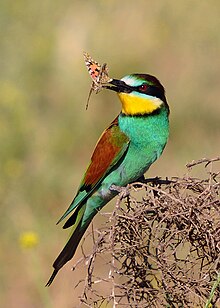European Bee-eater
| European Bee-eater | |
|---|---|
 | |
| Conservation status | |
| Scientific classification | |
| Kingdom: | Animalia |
| Phylum: | Chordata |
| Class: | Aves |
| Order: | Coraciiformes |
| Family: | Meropidae |
| Genus: | Merops |
| Species: | M. apiaster |
| Binomial name | |
| Merops apiaster Linnaeus, 1758 | |
The European Bee-eater (Merops apiaster), is a near passerine bird in the bee-eater family Meropidae. It breeds in southern Europe and in parts of north Africa and western Asia. It is strongly migratory, wintering in tropical Africa, India and Sri Lanka. This species occurs as a spring overshoot north of its range, with occasional breeding in northwest Europe.
This species, like other bee-eaters, is a richly-coloured, slender bird. It has brown and yellow upper parts, whilst the wings are green and the beak is black. It can reach a length of 27–29 cm (10.6–11.4 in), including the two elongated central tail feathers. Sexes are alike.
This is a bird which breeds in open country in warmer climates. Just as the name suggests, bee-eaters predominantly eat insects, especially bees, wasps and hornets which are caught in the air by sorties from an open perch. Before eating its meal, a European Bee-eater removes the sting by repeatedly hitting the insect on a hard surface. It eats some 250 bees daily. Lizards and frogs are also taken.
These bee-eaters are gregarious, nesting colonially in sandy banks, preferably near river shores, usually at the beginning of May. They make a relatively long tunnel in which the 5 to 8, spherical white eggs are laid around the beginning of June. Both the male and the female take care of the eggs, which are brooded for about 3 weeks. These birds also feed and roost communally.
The call is a pleasant distinctive trill.
Reported UK breeding attempts
European Bee-eater has attempted to nest on five occasions in Britain:
- In 1920, a pair made a nesting attempt in a sand bank of the River Esk at Musselburgh,Scotland. A local gardener captured the female, keeping her in a greenhouse, and she died two days later, after laying a single egg.
- In 1955, three pairs of Bee-eaters nested in Streat sand quarry near Plumpton, East Sussex. The birds were first found on 12 June, although the birds' presence only became widely known at the start of August. One nest was accidentally destroyed by machinery in July, but seven young fledged from the two remaining nests towards the end of August. An RSPB wardening operation was instigated, and in total over 1,000 people visited the site. The birds remained until 24 September.
- A pair nested at Bishop Middleham Quarry, County Durham in 2002. The birds were first found on 2 June, and within a few days started to undertake courtship feeding and copulation; five chicks hatched, but one died in the nest, one died before fledging, and a third disappeared and was also believed to have died. Durham Wildlife Trust (with RSPB assistance) set up a wardening post during the period when the birds were nesting. News was released to rare bird information services, and the national news media also reported on the birds' presence. In total, some 15,000 people visited the site during their stay; the adults and both fledged young were seen to leave on 28 August, when they flew off high to the south.
- A pair took up residence on farmland adjacent to the River Wye, near Hampton Bishop, Herefordshire in summer 2005; by mid-July the adults were bringing insect food to the riverbank nest-hole confirming that eggs had hatched. A wardening operation was set up by the RSPB, with public access granted, resulting in c. 2,000 people seeing the birds. However, on the evening of 29 July, foxes predated the nest, and the birds soon left the site.
- A pair excavated a nest hole at a coastal site in Dorset in 2006, but this attempt failed (Birdwatch no. 173 p. 23).
Fiction
- The third series of the sitcom To the Manor Born featured an episode, first aired on 11 August 1981, in which Bee-eaters bred at a fictional location in England .











No comments:
Post a Comment